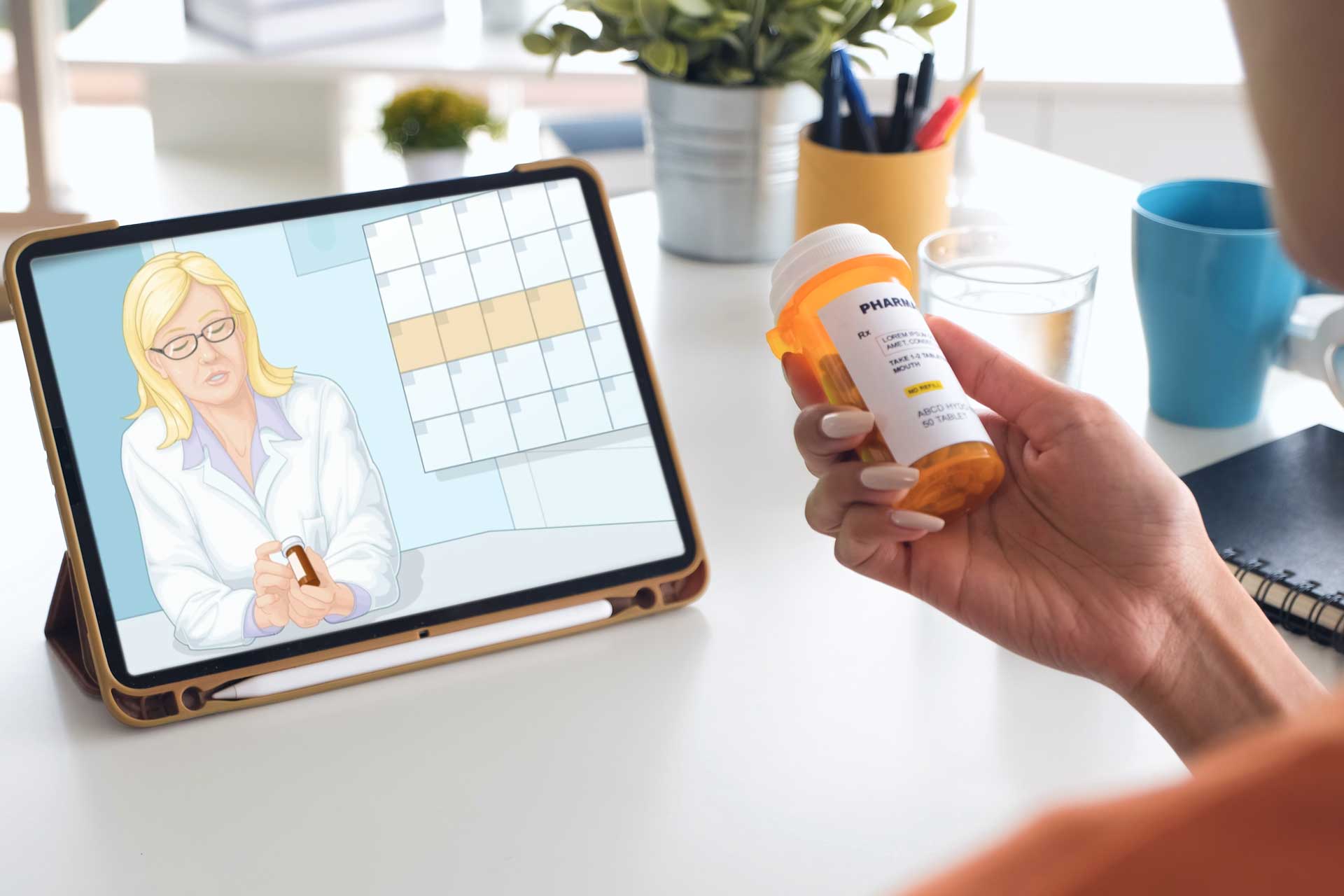
Wolters Kluwer, Health announces the release of EmmiEducate to improve alignment between patients and their care teams. With educational content tailored to a variety of learning and reading styles, and interoperability across disparate systems and access points, EmmiEducate gives providers the ability to easily support their patients’ information needs within their workflow, delivering easy-to-understand educational materials that mirror the guidance provided to patients during the clinical encounter.
Meeting patients where they are
EmmiEducate aids the expansion of virtual care delivery and helps providers reduce health inequities by more effectively reaching diverse populations through multiple touch points and modalities. EmmiEducate features hundreds of compelling videos, more than 8,000 leaflets in up to 20 languages, and presentation of educational materials at a fifth- to seventh-grade reading level, helping care teams provide content to patients in ways they can better understand and act on.
“How patient education is developed and shared directly impacts whether or not it will be used. Done right, educational touchpoints can improve patient understanding and adherence to their treatment plan, enhance the overall care experience, and build organizational affinity,” said Jason Burum, general manager, healthcare provider segment, clinical effectiveness, at Wolters Kluwer, Health. “By extending clinical decision support to patients, EmmiEducate aligns healthcare stakeholders in a manner that is convenient and highly effective for improving outcomes.”
Continue Reading

Hospital-acquired infections are a challenge to clinicians as they increase the mortality and morbidity rate. Sources of infections in hospitals include pathogens from patients, inanimate environments, and medical personnel. In any healthcare delivery setting, infection control and prevention standard precautions should be taken into account. It is everyone’s responsibility to exercise the following tips to prevent exposure and contamination in hospitals. This way, they can avoid causing unnecessary suffering and pain to patients and their loved ones.
Thorough cleaning
Regular cleaning of surfaces in the hospital is among the common practices that ensure hygiene is maintained. Many people visit the hospital daily, including patients, medics, suppliers, or family members visiting their loved ones. Everyone comes from different settings where there are high chances of exposure to germs and environmental elements like dirt and dust. These are among the leading causes of infection in hospitals.
Every hospital must hire cleaning services to ensure that every surface is free of dirt. Provide clean water, detergent, and equipment to make cleaning efficient and fast. Thorough cleaning eliminates over 90% of microorganisms and bacteria by suspending them in the cleaning fluid and removing them from the surfaces.
Hand hygiene
Healthcare workers come into contact with many patients and hospital equipment as they go about their duties. They are, therefore, the most frequent drive for nosocomial infections, and hand hygiene is an ideal preventive measure. Hand hygiene involves disinfection and regular hand washing. Washing hands thoroughly with running water and soap eliminates over 90% of most or all of the superficial and flora contaminants.
When your hands are dirty, use antimicrobial soap for hand-washing to reduce transient flora, but when you come into contact with an infected patient, use medicated soap or an alcohol-based hand-disinfectant. During an operation, many gloves tear. Therefore, disinfect your hands with a long-acting disinfectant before wearing gloves.
Isolation of infected patients
Patients with nosocomial infections should be kept in isolation as a first essential measure. There are different kinds of isolation depending on the extent of risk of infection. For extremely infectious diseases, such as diphtheria and hemorrhagic fever, isolation measures are stringent, while infectious diarrhea and less-infectious respiratory infections aren’t as stringent.
Since isolation is a labor-intensive and expensive process for healthcare workers and patients, it should be adapted to causative agents and disease severity. Practice standard precautions of isolation by wearing protective equipment and keeping patients in private rooms away from other patients. Also, minimize interaction with isolated patients by ensuring they are tended to by a few medical personnel and hospital staff.
Continue Reading
 BLACK+DECKER launches BLACK+DECKER Health – a new product category within the BLACK+DECKER brand that will be dedicated to providing health and wellness solutions direct-to-consumers. As part of this announcement, the company has introduced goVia, a new product line of emergency response systems (PERS) designed to promote confident mobility for active older Americans.
BLACK+DECKER launches BLACK+DECKER Health – a new product category within the BLACK+DECKER brand that will be dedicated to providing health and wellness solutions direct-to-consumers. As part of this announcement, the company has introduced goVia, a new product line of emergency response systems (PERS) designed to promote confident mobility for active older Americans.
“For more than 110 years, BLACK+DECKER has been a trusted manufacturer of power tools and products for the home,” said Sean O’Brien, product director, BLACK+DECKER Health. “Now, as part of BLACK+DECKER Health, goVia will help provide an extra layer of protection at home and on-the-go to create a world in which active older Americans can be more confident, maintain their lifestyle, and age in place.”
Each product in the goVia line of personal emergency response systems features 24/7 monitoring with a paid monthly subscription powered by Medical Guardian, a leading provider of innovative, connected care solutions for older adults and caregivers which will connect users to trained emergency operators should they need any assistance.
Continue Reading

The medical profession has come a long way from the days when doctors made house calls carrying little black bags with everything they needed for their trade. Changes have occured to the medical profession that have greatly improved the overall health care that patients have access to. Advances in technology have been able to both help improve health outcomes and wellbeing. Technology allows doctors to gain real time data about how their patients are doing. While there are many areas where technology helps patient outcomes, four that should be highlighted include telemedicine, decreasing financial burdens, improving patients’ access to care, and allowing patients to take more control over their own health and wellbeing.
Continue Reading

If you see an infant or child not feeling well, it can be heartbreaking, and the first instinct is usually you need to do something about it. Taking care of pediatric patients can be a challenging task, but it is worth it. As a pediatric nurse, you are a certified registered nurse tasked with caring for children in different healthcare settings regardless of age. Therefore, if you choose this career path, you have to be very knowledgeable about issues concerning the growth and development of kids during different stages of their life cycle. In addition, as a pediatric nurse, you are expected to understand the experience of the child’s family and work with them to offer the best pediatric care possible.
Becoming a pediatric nurse requires you to go through extra education, need an advanced nursing degree, and gain certification from the pediatric nursing certification board. Once you have it all, you can begin your practice. Many people might not be convinced whether they would want to pursue their career, but it is worth it. The following are some of the reasons why a job as a pediatric nurse practitioner is pretty satisfying:
You get to make kids number one
If you are interested in becoming a pediatric nurse, rest assured that kids are one of the things that make your job lively. If you enjoy their company, respect them, and would love to care about them, then you are on the right career path. Whether dealing with newborns or teens or anyone in between, you can be sure your career will never have a dull moment.
Continue Reading
 Application security involves a process that allows companies to find security vulnerabilities and protect their applications against them. IT teams look at vulnerabilities and use past events as a way to assess the risk of other potential risks.
Application security involves a process that allows companies to find security vulnerabilities and protect their applications against them. IT teams look at vulnerabilities and use past events as a way to assess the risk of other potential risks.
This post covers more about what application security is, along with the risks and measures that can be taken to keep your applications more secure.
Application Security Explained
Application security teams work within organizations to prevent cyber criminals from gaining access to confidential data. They work to also prevent modifications from being made by users who have the proper authentication too.
Application security testing lets you find all users who are authorized. It also lets you know the level of access that they have. This can be useful for helping you identify if certain users are authorized to be accessing certain data.
IT teams are also able to find all of the vital assets within a business to ensure that they’re properly secure. In addition to this, teams can identify vulnerabilities within an application to put better measures in place to prevent the vulnerabilities from being exploited.
Application security allows organizations to put actionable plans into effect that reduce the risk of threats whilst also allowing teams to remediate attacks if they occur. Being able to view security threats and repair vulnerabilities in real-time is what makes application security so effective.
Continue Reading
Patient ID Now, a coalition of leading healthcare organizations, including the American College of Surgeons, the American Health Information Management Association (AHIMA), the College of Healthcare Information Management Executives (CHIME), Healthcare Information and Management Systems Society (HIMSS), Intermountain Healthcare and Premier Healthcare Alliance, is pleased that the U.S. House of Representatives has removed, for the third year in a row, the longstanding ban in its Labor, Health and Human Services, Education, and Related Agencies appropriations bill that stifles innovation around patient identification.
Patient ID Now has brought attention to the need for a national strategy around patient identification that offers both improved patient safety and improved efficiency to healthcare, well as enhanced interoperability. Although patient misidentification has been a problem for decades, the COVID-19 pandemic heightened the harmful effects of the health system’s inability to accurately match patients to their complete health records.
An archaic section of the federal budget has prevented the U.S. Department of Health and Human Services from working with the private sector to develop a nationwide patient identification strategy, but today the House of Representatives, with leadership from Representative Bill Foster (D-IL) and Representative Mike Kelly (R-PA), once again took an important step forward in repealing this ban.
The coalition is now calling on the U.S. Senate to finally join the bipartisan work of the House of Representatives and repeal the ban this year to work towards a health system that prioritizes the safety and privacy of patients.
“The pandemic made clear that now is the time to take action to ensure the health and safety of patients across the US and bolster the accuracy and interoperability of health data,” said AHIMA CEO Wylecia Wiggs Harris, PhD, CAE. “Moving the appropriations bill forward without this harmful ban is the first step toward finding a strategy that can lead to better safety and care outcomes.”
Throughout the pandemic the healthcare industry has struggled to resolve this difficult operational issue. Ensuring the correct patient medical history is accurately matched to the patient is critical for future patient care, patients’ long-term access to their complete health record, accurately tracking vaccination status, and monitoring the long-term effects of COVID-19.
“ACS applauds Congress in taking necessary and overdue first steps in working towards the trusted, digital identity of patients so that surgeons can exchange information on their behalf,” said American College of Surgeons’ medical director of quality and health policy Frank Opelka, MD, FACS. “Our patients deserve trusted, shared information as they navigate a complex healthcare system.”
Here is what leaders of other coalition member organizations said about the recent vote:
- “Today, because of a narrow interpretation of an outdated appropriations restriction, there is no consistent and accurate way of linking a patient to their electronic health information as they seek care across the health care continuum. This essential but missing functionality would add significantly to providers’ ability to manage care safely, and if it were in place, it would assist in effectively battling the coronavirus. We applaud the House Appropriations Committee for lifting the restriction and urge the Senate Appropriations Committee to do the same,” said Intermountain Healthcare President and Chief Executive Officer Marc Harrison, MD.
- “HIMSS applauds the House Appropriations Committee for taking critical steps to eliminate the outdated and harmful ban on a unique patient identifier,” said HIMSS President & CEO Hal Wolf. “We must now focus on advancing a nationwide patient matching and identification strategy that supports patient safety through interoperable digital health information exchange and strengthens patient privacy rights. We urge the Senate to follow the House of Representatives and remove the ban.”
Clinical trials of medications, medical equipment, and medical procedures are a vital part of medical research. Clinical trials can lead to groundbreaking results for patients and their families. This has been illustrated recently with the clinical trials and FDA approval of vaccines for COVID-19. The vaccines approved from clinical trials have been administered to hundreds of millions of people around the globe and have saved countless lives. Medical research and clinical trials are ongoing daily and continue to deliver lifesaving as well as life prolonging measures to advance medical care and the human condition.
One of the most important aspects of any clinical trial are patient surveys. Patient surveys used in clinical trials are used in a number of ways, all of which improve researcher knowledge of a patient’s medical and biological background. Quality of life surveys are used by medical researchers to determine how a patient is feeling during the trial. One measurement of how well a medication is working is if a patient, especially a patient who is a senior, has a debilitating chronic illness or who has a terminal disease feels their quality of life has been improved because of the medication. Here is more information on the use of quality of life surveys during the clinical trials process.
Continue Reading




 Application security involves a process that allows companies to find security vulnerabilities and protect their applications against them. IT teams look at vulnerabilities and use past events as a way to assess the risk of other potential risks.
Application security involves a process that allows companies to find security vulnerabilities and protect their applications against them. IT teams look at vulnerabilities and use past events as a way to assess the risk of other potential risks.